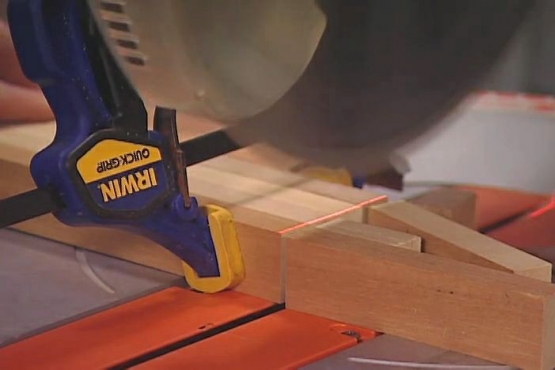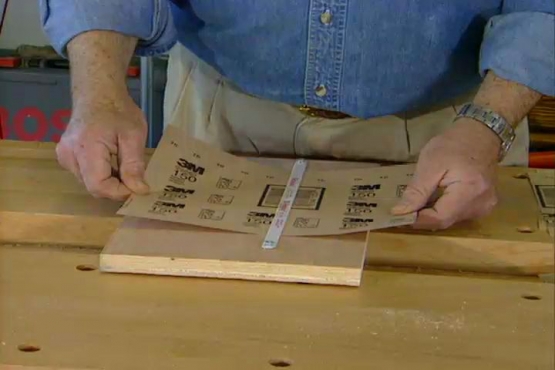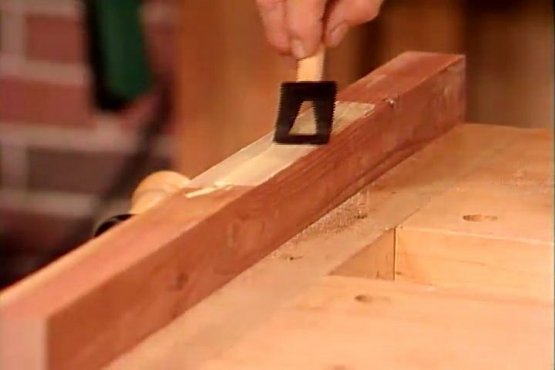RON HAZELTON:
This is my friend Emily. Hi, Emily.
EMILY:
Hi, Ron.
RON HAZELTON:
How are you?
EMILY:
Good.
RON HAZELTON:
Emily is a wonderful cook. Absolutely exquisite food that she prepares. But she's been saying that she needs a cutting and chopping board. If we were going to make a custom board, which is exactly what we are going to do, what are some of the features you'd like to have in that?
EMILY:
I'd want it to be really solid, so that when I chop a lot, it doesn't wiggle all over the place and bounce around. And I also don't want it to warp after a while. And I also want to be able to just scrape everything off into the bowls 'cause I'm kind of messy in the kitchen. So I'd like —
RON HAZELTON:
No.
EMILY:
Yeah, just a little bit. Do you think you can do that?
RON HAZELTON:
I believe so. I think we can design and build a cutting board that will do all of that for you.
EMILY:
Excellent. If we get the cutting board that I would love, then I'll make you a salad that I hope you'll at least like a little bit.
RON HAZELTON:
Yeah?
EMILY:
Yeah. [LAUGHS]
RON HAZELTON:
That's a good deal.
EMILY:
It is?
RON HAZELTON:
Okay, yeah.
EMILY:
Great.
RON HAZELTON:
Emily's cutting board challenge begins appropriately enough, with some cutting. In this case, three 17-inch long maple boards.
Now we're going to actually push these together, eventually glue them together and form that wide board for the cutting board.
EMILY:
But you said, you told me before, we had to alternate the grain, right?
RON HAZELTON:
Right. If you look at the end right here, you'll see the grain runs in different directions. This one runs this way, this one runs this way. They're sort of like in arcs. The idea is you want to alternate those to minimize the warping in the board.
EMILY:
Excellent.
RON HAZELTON:
Next, we apply wood glue to the edges of the boards and clamp them together while the glue dries.
Now we want to take a little bit of time to sand this. And this is a belt sander. We're going to do two things here — we're going to kind of sand this at kind of a diagonal to the way the grain is running to flatten each board, relative to the next one.
And then once we've done that, we're going to go with the grain, back and forth like this.
EMILY:
[LAUGHS] It, it ran away from me.
RON HAZELTON:
Emily quickly gets used to the power of the belt sander and smooths out the surfaces. Then she takes a few more passes with a random orbital sander and progressively finer grades of sand paper.
Okay, now feel that. Isn't that nice?
EMILY:
Oh, my God, that's awesome.
RON HAZELTON:
By using progressively finer sandpapers, we get rid of all those marks and we also ended up with something that's just glass-smooth here.
EMILY:
Fantastic.
RON HAZELTON:
Now, let's take this over to the table saw.
EMILY:
Right.
RON HAZELTON:
Because if you notice here, there are ragged ends. Now we're going to clean that up by trimming it off on the table saw. This is our table saw cradle.
EMILY:
This is.
RON HAZELTON:
Mm-hmm [AFFIRMATIVE]. It's a piece of wood, it just slides on top of the table. So what I want you to do is to kind of grip out here, pull this back so that it's pushing it against this rail. Then you're going to slide this whole thing through. [SAWING SOUNDS]
Now look how nice and clean and straight that edge is.
EMILY:
That's excellent and it looks like you've cut this from one piece of wood.
[MUSIC]
RON HAZELTON:
Solid, it's not going to warp. Now I want to make it easy to get the food off here and into a bowl.
EMILY:
Excellent.
RON HAZELTON:
So what we're going to do is, we're going to make a cutout right here, which is roughly in the shape of the bowl. Slightly smaller. And we're going to mount this up on some legs so that you'll be able to push food from here right into the bowl.
We pass the board through the band saw, following the cut line for the bowl. Next, we remove any saw marks, using the drill press and a drum sander attachment.
So we've got a nice cutout here. And that's going to go right over your bowl like this. So that as you chop, you can now pull things off and right into the bowl.
EMILY:
But you know, it's, it's still a little high. And I mentioned before, I'd kind of like to have it inside, I think.
RON HAZELTON:
You're just never happy.
[EMILY LAUGHS]
I'm just kiddin' you.
EMILY:
I know you can do it, Ron.
RON HAZELTON:
Actually, I think you're right. If we can lower this down a little bit, it will look better. And so what I'm going to propose is we cut away a little bit of material right here and this will kind of slip over the bowl.
EMILY:
Mm-hmm [AFFIRMATIVE].
RON HAZELTON:
Or the bowl will kind of slip up inside the carving board, the cutting board. And the way we're going to do that is by routing it out. If you can hand me the router over there, I'll show you the tool.
EMILY:
Ah, that's what this is for.
RON HAZELTON:
Yeah. We got a cutter bit in here. This is called a rabbiting bit. It's got a ball bearing guide right here. The ball bearing is going to follow right along the edge of our cutout here. And this bit is going to kind of remove a little bit of material, sort of a step, I'm going to create a step on the bottom.
Here we go, how's that?
[EMILY LAUGHS]
Next, we return to the drill press to bore four leg sockets in the bottom of the cutting board.
Very nice. [SOUNDS OF DRILL]
EMILY:
That’s it. That’s the last one.
RON HAZELTON:
We brush glue inside the holes, then tap in short pieces of dowel.
[BOTH SPEAK AT ONCE]
Now I want to put on a protective coating because you're going to have food on this and, and liquids. This is mineral oil. It's an inner oil, that means it won't get rancid and it's non-toxic so it won't hurt you if it does get in — come into contact with food. Perfect for this. We're just going to put some of this on the top like so.
We actually sand the mineral oil into the board, using number 400 wet and dry paper.
We finished the carving board. You happy with it?
EMILY:
I am. I, I'm so happy with it, I almost don't want to chop on it.
RON HAZELTON:
I don't want you to chop on it either, actually. [LAUGHS] But you know, that's what it's for.
EMILY:
[LAUGHS] All right. Well, we'll — we'll chop very lightly.
[BOTH SPEAK AT ONCE]
RON HAZELTON:
So now you're — well, we put the board right to work, chopping apples and nuts for Emily's special Waldorf salad.
Hmmm.
EMILY:
You like it?
RON HAZELTON:
I never would have thought of putting curry in there. That's really good.
EMILY:
Good.
RON HAZELTON:
And so well-chopped too.
EMILY:
Well, thank you for that. And thank you for that cutting board. I wouldn't have been able to do it without that.
RON HAZELTON:
You're very welcome.
EMILY:
And I can't wait to take it home and use it in my own kitchen.
RON HAZELTON:
I hope you'll enjoy it. You had a big part in making this, you know.
EMILY:
It was fun.









